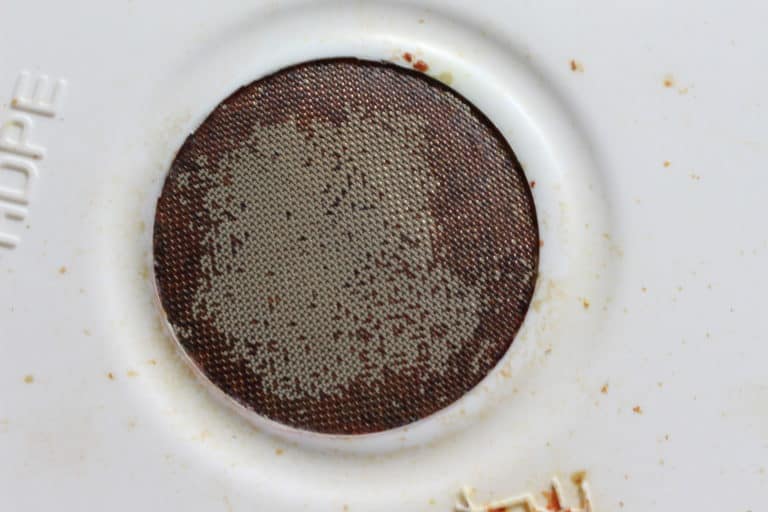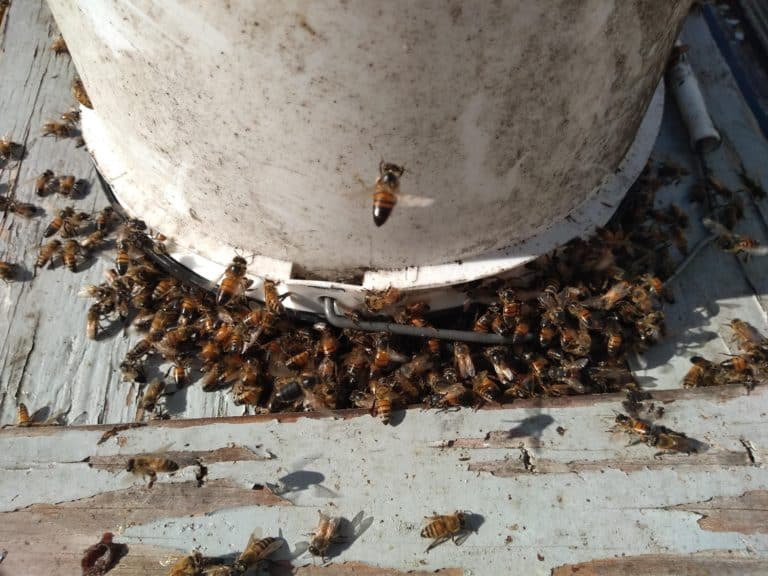The best method for feeding bees is a topic that most beekeepers have an opinion about, and of course they are all right. In this previous post I discussed the pros and cons of frame feeders for in-hive feeding. In this post we’ll go through gravity feeders, which are the other type of commonly used feeders. Hopefully the information in these posts will give you confirmation that you are using the right method for you and your bees or inspire you to try something different.
Gravity style feeders are placed on top of hives and as you may have guessed, use gravity (in balance with vacuum pressure) to deliver the syrup to bees inside the hive. Gravity feeders go by a variety of names among beekeepers, including pails, feed buckets, jugs, syrup cans, and contact feeders. The basic design is a sealed container filled with syrup which is then inverted on top of the hive. Inverting the container forms a vacuum at the top of the container (after a couple drips) that prevents the syrup from all pouring out provided the container is airtight. The bees can then access the syrup from below without exiting the hive.

Photo: Dan Wyns
The container types used to accomplish this vary widely. Plastic buckets are often used, with 1, 2, and 3 gallon sizes being common. Buckets lids will have either an array of small holes or a patch of fine mesh which syrup can be taken through.

Photo: Dan Wyns

Photo: Dan Wyns
Rectangular metal or plastic cans are also common, particularly in western states. Pin holes in the screw top lids provide access to the syrup when inverted on a hive. Other containers like soda bottles or mason jars can also be repurposed as gravity feeders, provided the lid can be modified with holes or mesh and the container can be made airtight (aside from the holes in the lid). It is very important that the container does not leak. Any leaking inside or outside the hive can provide stressful in-hive conditions from syrup dripping on bees to inciting robbing if leaking outside of the hive.

Photo: Dan Wyns

Photo: Dan Wyns
Hive equipment must accommodate the use of a gravity feeder so that bees can have access to the syrup without exposing the entire colony to the elements or robbing. In commercial operations, this accommodation is accomplished by incorporating a hole into the hive lid design. These holes have covering flaps or removable caps so they can be opened when gravity feeders are in place and then closed back up when not feeding. These caps tend to work reasonably well but do represent one more item that can get lost or broken, and when they are damaged or missing they may create a point of entry for precipitation or robbers.

Photo: Ana Heck
For small-scale beekeepers it is most common for feed buckets to be used inside an empty box where they are set over the central hole of an inner cover and then covered with a telescoping lid. This provides access while excluding robbers but does require having extra empty boxes on hand and storing both the boxes and buckets when not in use.
Feed buckets or cans in commercial operations are not typically filled in the field. Care must be taken when mixing syrup for gravity feeders in order to thoroughly dissolve all sugar. Any remaining crystals will settle, potentially blocking the holes or mesh when the bucket is inverted. Buckets or cans are usually filled at the workshop, stacked in containers for transportation, placed on hives, and then once empty they are collected and returned to the workshop for cleaning and refilling. Filling buckets at the shop means they can be applied without opening hives or otherwise disrupting bees. On a return visit, syrup consumption can also be assessed quickly without opening hives. Since they are only used on hives seasonally, they are an additional piece of equipment that needs to be stacked and stored for much of the year. A few empty buckets for a small-scale beekeeper isn’t a big deal, but at the commercial-scale, storage and transport typically involve construction of pallet sized bins that will hold dozens to hundreds of feeders that can be moved and stacked with forklifts.

Photo: Dan Wyns
One aspect of a bucket feeder that is nice is the relatively slow rate at which the bees take syrup from it. Bucket feeders can provide steady and sustained stimulation which is particularly beneficial to colonies building in the spring. Feeding a newly hived package is a scenario where a gravity feeder on top is an excellent way to get feed to the colony. Having syrup immediately available above the cluster of bees provides easy access compared to traversing several frames to get to a frame feeder at the edge of a box. In northern climates known to have cold springtime weather, bucket feeders are typically used to feed newly hived package colonies because bees can starve to death if their feeder, such as a frame feeder, is too far from the cluster. The prolonged availability of feed from a bucket provides syrup while the queen settles into laying and while the colony begins to draw comb. The gravity feeder will also eliminate any potential for drowning so long as the bucket is not leaking down into the cluster.

Photo: Dan Wyns
As spring approaches many beekeepers will be considering if and when they need to feed their colonies; hopefully this post and the previous one on frame feeders have provided some useful things to consider when deciding the how.
